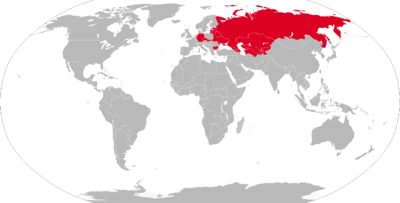OTR-23 Oka
The OTR-23 Oka (Russian: OTP-23 «Ока»; named after Oka River) was a mobile theatre ballistic missile (Russian: оперативно-тактический ракетный комплекс) deployed by the Soviet Union near the end of the Cold War to replace the obsolete SS-1C 'Scud B'. It carried the GRAU index 9K714 and was assigned the NATO reporting name SS-23 Spider. The introduction of the Oka significantly strengthened Soviet theatre nuclear capabilities as its range and accuracy allowed it not only to strike hardened NATO targets such as airfields, nuclear delivery systems, and command centers, but moving targets as well. It also had a fast reaction time, being able to fire in approximately five minutes, and was nearly impossible to intercept, thereby allowing it to penetrate defenses.[1]
| OTR-23 Oka SS-23 Spider | |
|---|---|
A 9P71 TEL at the National Museum of Military History in Sofia, Bulgaria. | |
| Type | Theatre ballistic missile Short-range ballistic missile |
| Place of origin | Soviet Union |
| Service history | |
| Used by | See Operators |
| Production history | |
| Designer | KB Mashinostroyeniya (Kolomna) |
| Manufacturer | Votkinsk Machine Building Plant |
| Produced | 1979 – 1987 |
| Specifications | |
| Mass | 4,360 kg (9,610 lb) |
| Length | 7.53 m (24.7 ft) |
| Diameter | 0.89 m (2 ft 11 in) |
| Warhead | Nuclear 50-100 kt, HE fragmentation, submunition, or chemical |
| Engine | Single-stage Solid-fuel rocket |
Operational range | 500 km (310 mi) |
Guidance system | Inertial with terminal topographic DSMAC active radar |
| Accuracy | 30–150 m CEP |
Launch platform | Mobile TEL |
The main components of the 9K714 system were:[2]
- the transport and launch vehicle PU 9P71 (Russian: cамоходная пусковая установка), based on the amphibious BAZ-6944
- the similar transporter-loader TZM 9T230 (Russian: транспортно-заряжающая машина) with one spare missile and equipped with a hydraulic crane
- the re-supply vehicle TM 9T240 (Russian: транспортная машина), a ZIL-131 tractor with semi-trailer to transport a missile (in transport container 9Ya249) and a warhead (in a 9Ya251 container)
The operational life of the Oka was limited and controversial. The Soviet military asserted that the Oka had a maximum range of 250 miles (400 km). American experts, however, estimated it had a greater range. In 1987, Mikhail Gorbachev proposed to George Shultz that he would unilaterally remove all Okas, if it would prevent the United States from building up its own short-range nuclear forces in Europe, despite the fact that the Soviet military was in favor of the Oka. Shultz however lacked the authority to act on the suggestion.[3] Gorbachev included the Oka in the class of systems to be discontinued as part of the INF Treaty as a gesture of goodwill, even though Soviet assertions of its maximum range did not put it outside the specifications of the treaty.
There was diplomatic controversy over this weapons system in April 1990, when the Soviets informed the US of their covert transfer of at least 120 missiles to the Warsaw Pact states of Czechoslovakia, Bulgaria, and East Germany during the time of negotiation of the Intermediate-Range Nuclear Forces Treaty. Evidence indicates that the missiles were transferred with conventional warheads only, although equipment to load Soviet nuclear warheads was apparently retained.[4]
Missile variants
- The 9M714B missile armed with the AA-60 (9N63) nuclear warhead and possessing a maximum range of 500 km
- The 9M714F missile armed with a FRAG-HE warhead weighing 450 kg and possessing a maximum range of 450 km
- The 9M714K missile armed with a submunitions warhead 9N74K weighing 715 kg and possessing a maximum range of 300 km
In addition to these warheads, the SS-23 was also reported to be able to deliver chemical munitions.
Operators

Former operators

- Phased out in 2002

- Phased out in the 1990s

- Passed on to successor states

- Phased out in the 1990s, shortly before the reunification with West-Germany

- Phased out in 2000

- Phased out as directed by the INF Treaty
See also
Notes
- http://www.missilethreat.com/missilesoftheworld/id.142/missile_detail.asp Archived 2007-09-29 at the Wayback Machine MissileThreat: SS-23
- ru:Ока (ОТРК)
- David Hoffman, The Dead Hand: The Untold Story of the Cold War Arms Race and Its Dangerous Legacy (Random House, 2009), 283-284.
- https://fas.org/nuke/guide/russia/theater/ss-23.htm SS-23 SPIDER - Russian / Soviet Nuclear Forces
External links
| Wikimedia Commons has media related to OTR-23 Oka. |